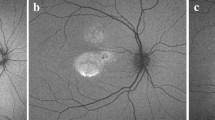Abstract
Background
To evaluate the pattern electroretinogram (PERG) in central serous retinopathy.
Methods
In this prospective study, 20 patients with recent onset (<6 weeks) unilateral CSR were studied with the fellow eye acting as control. BCVA, psychophysical parameters, FFA, OCT, flash and pattern ERG were evaluated.
Results
The mean P50 amplitude in the affected eye at presentation was 2.36 ± 0.8 μv compared to 3.24 ± 0.85 μv in the normal eye. At 12 weeks, the mean P50 amplitude in the affected eye was 3.16 ± 0.88 μv compared to 3.63 ± 0.82 μv in the normal eye. The reduction of 27 % in P50 amplitude even after recovery was statistically significant (P < 0.001). A reduction of 19.77 % in the amplitude of N95 wave in the affected eye compared to the normal eye was seen, which was statistically significant (P < 0.001). In the affected eye, there was statistically significant improvement in the psychophysical tests at 12 weeks.
Conclusions
This study reveals that P50 component of the PERG is reduced in cases of CSR, indicating functional disturbance of the macular photoreceptors. A normal flash ERG indicates that pathology is electrophysiologically localised to macula without affecting general retina. Residual deficit in the PERG explains poor quality of vision in spite of normal anatomical apposition and quantitative 6/6 visual acuity.


Similar content being viewed by others
References
Marmor MP (1988) New hypothesis on the pathogenesis and treatment of serous retinal detachment. Graefes Arch Clin Exp Ophthalmol 226:548–552
Guyer DR, Tanuzzi LA, Slakter JS et al (1994) Digital indocyanine green video angiography of central serous chorioretinopathy. Arch Ophthalmol 112:1057–1062
Ciardella AP, Guyer DR, Spitznas M (2001) Central serous chorioretinopathy. In: Ryan S (ed) Retina, vol 2. Mosby, St Louis, pp 1153–1181
Legras M, Coscas G (1971) Oedematous maculopathies and colour sense. Mod Prob Ophthalmol 11:111–116
Spitznas M, Huke J (1987) Number, shape and topography of leakage points in acute central serous retinopathy. Graefes Arch Clin Exp Ophthalmol 225:437–440
Hee MR et al (1995) Optical coherence tomography of central serous chorioretinopathy. Am J Ophthalmol 120:65–74
Lida T et al (2000) Evaluation of central serous chorioretinopathy with optical coherence tomography. Am J Ophthalmol 129:16–20
Holder GE (1985) Pattern ERG abnormalities in anterior visual pathway disease. Electroencephalogr Clin Neurophysiol 61:s135
Sverak J, Wassermann Ova V, Peregrin J (1962) Electroretinographic approach to the problems of the pathogenesis of central serous retinopathy. Acta Ophthalmol 40:54–64
Papakostopoulos D, Dean Hart C, Cooper R, Nastikos V (1984) Combined electrophysiological assessment of the visual system in central serous retinopathy. Electroencephalogr Clin Neurophysiol 59:77–80
Eckstein MB, Spalton DJ, Holder G (1933) Visual loss from central serous retinopathy in systemic lupus erythematosus. Br J Ophthalmol 77:607–609
Laantikainen L, Hoffren M (1991) Long term follow up study of non senile detachment of retinal pigment epithelium. Eur J Ophthalmol 1:79–84
Lewis ML (1978) Idiopathic serous detachment of retinal pigment epithelium. Arch Ophthalmol 96:620–624
Straastma BR, Allen RA, Pettit TH (1966) Central serous retinopathy. Trans Pac Coast Otoophthalmol Soc 100:560–569
Gilbert CM, Owens SL, Smith PD et al (1984) Long term follow up of central serous chorioretinopathy. Br J Ophthalmol 68:815–820
Koshela et al (1994) Contrast sensitivity after resolution of central serous retinopathy. Graefes Arch Clin Exp Ophthalmol 232:473–476
Lu N, Zhang C (1992) Contrast sensitivity study in the fellow eyes of patients with central serous chorioretinopathy. Zhongguo Yi Xue Ke Xue Yuan Xue Bao 14(2):85–88
Smith VC, Pokorny J, Diddle KR (1978) Colour matching and stiles crawford effect in central serous choriodopathy. In: colour vision deficiencies. IV. In: Verriest G (ed) Modern problems in ophthalmology, vol 19. Karger, Basel, pp 284–295
Spitznas M (1989) Central serous retinopathy. In: Ryan SJ (ed) Retina. Mosby, St Louis, pp 217–227
Lida T, Hagimura N, Sato T, Kishi S (2001) Evaluation of central serous chorioretinopathy with optical coherence tomography. Am J Ophthalmol 129(1):16–20
Conflict of interest
There is no conflict of interest or financial disclosure.
Author information
Authors and Affiliations
Corresponding author
Rights and permissions
About this article
Cite this article
Goyal, J.L., Ghosh, B., Sangit, V. et al. Pattern ERG in central serous retinopathy. Doc Ophthalmol 130, 141–147 (2015). https://doi.org/10.1007/s10633-014-9475-5
Received:
Accepted:
Published:
Issue Date:
DOI: https://doi.org/10.1007/s10633-014-9475-5




